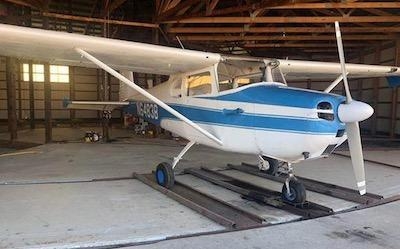Airplane Had Been Missing For Several Days, Pilot Was Not Certificated
The NTSB has released a preliminary report from an accident which occurred October 9th involving a Cessna 172 which went missing for nearly two weeks. The person flying the airplane, identified as 70-year-old Gerald Seliski, did not hold a pilot certificate, according to the FAA. He was fatally injured.

According to the report, the airplane was registered to and operated by Seliski. It was destroyed when it impacted terrain about 7 miles north of the Aberdeen Regional Airport (KABR), Aberdeen, South Dakota. The non-certificated pilot, who was the sole occupant, sustained fatal injuries. Dark night instrument meteorological conditions prevailed in the area and a flight plan was not filed. The flight originated from KABR about 2231 and its intended destination was Oaks, North Dakota.
According to records provided by the airport and a local fixed base operator (FBO), the airplane was flown to KABR by the pilot on September 30, 2019, to be assessed for an annual inspection. The pilot was informed by the FBO of what work needed to be accomplished to complete the annual inspection. The pilot decided not to have the work completed, and departed from ABR. Airport video surveillance records showed the airplane taking off from runway 31 about 2231 on October 9, 2019. The airplane wreckage was located on October 21, 2019, by a hunter and reported to local authorities. First responders identified the airplane and notified the Federal Aviation Administration (FAA) and National Transportation Safety Board (NTSB). The NTSB arrived on scene on October 22, 2019.
The weather at KABR about the time of the accident was recorded at 2253 and reported 350° 19 knots with gusts to 27 knots, visibility 7 mile in light rain, sky condition broken clouds at 700 ft, overcast clouds at 1,400 ft, temperature 5° dewpoint temperature 3°, altimeter 29.94, peek wind 340° at 27 knots. According to residents who live near the accident site, the weather was cold, windy, low clouds, fog, and mist on the night of October 9th.
The airplane's wreckage was in a farmer's field, about 7 miles north of ABR, grid coordinates: 45.561709 N -098.460366 W. On scene observations showed evidence that the airplane initially impacted a 60-ft tall tree with its left wing. Debris was scattered beyond the initial impact of the tree on a heading of 148°. The fuselage skidded along the ground for about 500 ft, and came to rest on the edge of a small pond. Both wings remained attached to the fuselage with extensive crush damage. The cabin section opened during the impact sequence. The tail separated about flight station (FS) 90 and was partially attached by control cables. The vertical fin and rudder separated during the impact sequence and were found about 15 ft in front of the main wreckage.
Flight control cable continuity was established from all control surfaces to the cockpit controls. All flight controls remained attached to the respecting surface. The flap handle (bar) was observed in the third notch (30° of flaps). The firewall and engine separated and was found about 20 ft in front of the main wreckage, submerged in standing water. The propeller assembly was found fractured at the engine crank flange and both propeller blades were twisted. The airframe fuel system could not be examined due to impact damage. Both fuel tanks were compromised and impact damaged.
Maintenance logbooks and the pilot's logbook were not found. After the on-scene examinations were completed, the wreckage was moved to a secure facility in Lakeville, Minnesota.
(Source: NTSB. Image from file)
 ANN's Daily Aero-Term (04.24.24): Runway Lead-in Light System
ANN's Daily Aero-Term (04.24.24): Runway Lead-in Light System ANN's Daily Aero-Linx (04.24.24)
ANN's Daily Aero-Linx (04.24.24) Aero-FAQ: Dave Juwel's Aviation Marketing Stories -- ITBOA BNITBOB
Aero-FAQ: Dave Juwel's Aviation Marketing Stories -- ITBOA BNITBOB Classic Aero-TV: Best Seat in The House -- 'Inside' The AeroShell Aerobatic Team
Classic Aero-TV: Best Seat in The House -- 'Inside' The AeroShell Aerobatic Team Airborne Affordable Flyers 04.18.24: CarbonCub UL, Fisher, Affordable Flyer Expo
Airborne Affordable Flyers 04.18.24: CarbonCub UL, Fisher, Affordable Flyer Expo



